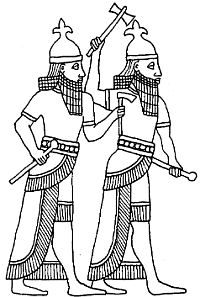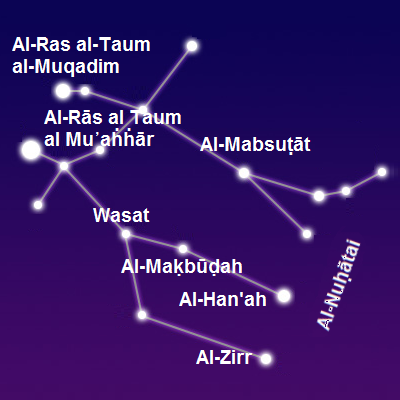Wikipedia
R.H. Allen:
Star Names
Ian Ridpath:
Star Tales
Universe Guide
Sea and Sky:
Constellations
IAU
Map
NASA:
Constellations
|
Wikipedia |
R.H. Allen: Star Names |
Ian Ridpath: Star Tales |
Universe Guide |
Sea and Sky: Constellations |
IAU Map |
NASA: Constellations |


|
|
GeminiStar Lore |
|


| Gemini is a large constellation of the Zodiac. It is one of the 48 original Ptolemaic Constellations. |


|
|
Ancient Babylon
In the MUL.APIN Tables, the stars later known as Castor and Pollux
were known as the Great Twins. The Twins were regarded as minor gods and were called
Lugal-irra and Meslamta-ea, meaning respectively "The Mighty King" and "The One who has arisen from the Underworld."
|
 Reconstruction of the Great Twins
Reconstruction of the Great TwinsGavin White: Babylonian Star-lore |


|
|
Ancient Greece
In Greek mythology, the constellation represents the twins Gemini represents the mythical
twins Kastor (Κάστωρ) and Polydeukes (Πολυδεύκης). Their names
were later latinized to Castor and Pollux.
|

|
Castor and Pollux grew up the closest of friends, never quarreling or acting without consulting each other.
Later, the twins joined Jason and the Argonauts
and more than once saved the entire endeavor.
 After the return of the Argonautes, Castor and Pullux got into a feud with Idas and Lynceus, two brothers who also had been Argonautes. In a quarrel over two women, Castor was killed by Lynceus who was then killed by Pollux. When Idas then attacked Pollux, Zeus intervened to save his son and struck Idas with a lightning bolt.
|
|  Castor and Pollux in "Urania's Mirror", 1824
Castor and Pollux in "Urania's Mirror", 1824Source: Wikipedia |
Pollux was immortal but Castor was destined for Tartarus after his death. Pollux asked Zeus to not
to outlive his brother. Zeus granted the wish not to outlive his brother and allowed them to split their time in the heavens and under the Earth.
To honor their brotherly love, he put an image of twins in the sky.
 An alternative view, reported by Hyginus, says that the constellation represents Apollo and Heracles (i.e. Hercules), both sons of Zeus but not twins.  Several star charts personify the twins as Apollo and Heracles showing them a lyre and arrow (attributes of Apollo) and club (attribute of Heracles).  Sources: Wikipedia, Ian Ridpath, Chandra Observatory Constellations site |

|

Ian Ridpath and Wil Tirion add that - as protectors of mariners - the twins were believed to appear in ship's rigging as the electrical
phenomenon known as St. Elmo's Fire.
 Source: Ridpath and Tirion: Stars and Planets
|

|


|
|
Norse Mythology
The formation Auguthjaza (Eyes of Þjazi), consisting of
Castor, and Pollux (α and β Gem),
is the only formation of stars mentioned in the Edda. Þjazi, anglicized as Thiazi, Thjazi, Tjasse or Thiassi was a Frost Giant
and a shapeshifter.
Wikipedia quotes the Skáldskaparmál,
the second part of the Poetic Edda, explaining how Þjazi's eyes made it into the skies.
|
 Þjazi, Odin, Loki and Hœnir
Þjazi, Odin, Loki and HœnirSource: Wikipedia
|
The Hárbarðsljóð is one of the poems in the
Poetic Edda, describing a verbal contest between Thor
and Odin who appeared as the ferryman
Hárbarðr (Greybeard).
 According to this poem, it was not Odin but Thor who claimed to have made Þjazi's eyes into stars:  In the poem, Thor said:  I killed Þjazi, the powerful minded giant. I killed Þjazi, the powerful minded giant. I threw up the eyes of Olvaldi's son I threw up the eyes of Olvaldi's son into the bright heavens. into the bright heavens.
 Source: Wikipedia |
 Thor by W. G. Collingwood
Thor by W. G. Collingwood |
 Hárbarðr by W. G. Collingwood
Hárbarðr by W. G. Collingwood
|


|
|
Grimms' Fairy Tales
The German fairy tale of Snow White and the Seven Dwarfs reaches its dramatic high point when
Snow White chokes on a poisoned apple and is laid to rest in a glass coffin.
|

|


|
|
Hungarian Mythology
The Hungarian word for "twins" is Ikrek. The word is used for the constellation Gemini, but the Hungarians have their own twins
tied to the legend.
|

|


|
|
Medieval Islamic Astronomy
R.H. Allen gives two Arabic names for the
constellation, both meaning "Twins." The older one was برج الجوزاء - Al Burj al Jauzā, the other one, used by Arab astronomers was
التوأمان - Al Tau᾽amān.
The stars of Gemini are also part of the ancient Arabic mega-constellation |
 Colored 15th century copy of
Colored 15th century copy ofal-Sufi's illustration Source: New York Times
|

In the al-asad constellation, Gemini's brightest stars, now known as
Castor (α Gem) and Pollux (β Gem), formed
the paw of Adh-dhira’a al-Mabsuta, The Extended Forearm. In that constellation,
they were called Al Awwal al Dhirāʽ (α Gem) and Al Thānī al Dhirāʽ (β Gem), the First and the Second in the Forearm.
 adh-dhira’ was also the name of the the Seventh Arabic Lunar Mansion, consisting of α and β Geminorum.  Al-Azfar, The Claws were formed by ρ, τ, ι, υ, κ, δ, λ, ζ and ε Geminorum.  In the ancient Arabic al-jawza’ constellation, γ and ξ Geminorum, together with η, μ and ν Geminorum were part of The Bow of Jawza.  Sources: R.H. Allen, Arab Star Calendar. Many of today's common names of Gemini's main stars are of Arabic origin: |
 Extended Forearm and Claws
Extended Forearm and ClawsSource: Arab Star Calendar
|

|

|
Official names derived from Arabic origins are shown in bold.
|

|
Around 964 AD, Persian astronomer Abd al-Rahman al-Sufi published his
Book of Fixed Stars, in which he assigned Arabic names to the stars and constellations identified
800 years earlier in Ptolemy's Almagest.
Al-Ras al-Taum al-Muqadim (α Gem) - The Head of the foremost Twin - was the name given
by Arabic astronomers to the star known as Castor in Greek astronomy.
|
 Colored Egyptian copy of
Colored Egyptian copy ofal-Sufi's illustration Source: diomedia.com
|

Al-Rās al Taum al Mu᾽aḣḣār (β Gem) - The Head of the hindmost Twin - was the name given
by Arabic astronomers to the star known as Pollux in Greek astronomy.
 In the ancient Arabic mega-constellation Al-Asad, the star was named Al Thānī al Dhirāʽ - the Second in the Forearm. al-Muwaqqit used the name Muekher al Dzira, the End of the Paw.  Sources: R.H. Allen, Wikipedia.
Alhena (γ Gem) comes from the Arabic Al Hanʽah, meaning "the Brand" (on the neck of the camel).
Together with μ,
ν,
η and
ξ Geminorum Alhena formed an asterism called Al Nuḥātai, the Camel's Hump.
|

Wasat (δ Gem) is the Arabic word for "Middle" which can be seen as the middle of the constellation but
according to R.H. Allen can also relate to to
the position of the star very near to the ecliptic, the central circle.
 Source: R.H. Allen
The names of Mebsuta (ε Gem) and
Mekbuda (ζ Gem) date back to the ancient Lion constellation
Al-Asad. Together with
ρ,
τ,
ι,
υ,
κ,
δ and
λ Geminorum, they formed the Claws
of the lion.
Alzirr (ξ Gem) comes from the Arabic al-zirr, meaning "Button". No explanation
for the origin of the name is given.
|
 Arabic Names of the stars of Gemini
Arabic Names of the stars of GeminiChart done by the author based on a map by seasky.org |


|
|
Ancient India
In Hindu Astronomy,
Castor, and Pollux (α and β Gem) are
the center of the seventh Nakshatra, called Punarvasu.
The word Punarvasu is derived from Puna+ Vasu, which means return, renewal, restoration or repetition.
|


|
|
Ancient China
In Chinese, Gemini is written
雙子座.
|

|
In 2017, the IAU Working Group on Star Names
approved the name Jishui for Omicron Geminorum and it is now so included in
the List of IAU-approved Star Names.
 A number of faint stars around η Gem form Yuè, a battle axe, used for decapitating the corrupt and immoral.  A number of stars from θ Gem to φ Gem form Wuzhūhóu, five feudal lords or princes who acted as the Emperor’s advisors and teachers. |
 The stars around δ Gem and ω Gem formed a triangle called Tiānzūn, the Celestial Wine Cup.  The largest part of present-day Gemini was taken up by Jǐng, the Well, which also gave its name to the entire Lunar Mansion, which, according to Ian Ridpath is the widest of the 28 mansions, extending for 33°.  This large asterism in the "legs of the Twins" resembles the Chinese character for ‘well’. Among others, it consists of γ, ε, ζ, λ, ξ, μ and ν Geminorum. |
 Chinese Well;
Source: dreamstime.com
Chinese Well;
Source: dreamstime.com
|
 Finally, also in the 22 Lunar Mansion is Shuǐwèi, the "Water Level". Ian Ridpath describes it as "...a curved line of four stars, that was usually seen as extending from Canis Minor into Cancer, but some older versions show it as the stars 68 to 85 Geminorum, in an example of how Chinese constellations have literally changed their spots with time."
Wikipedia lists two Gemini stars outside the 22nd Lunar Mansion:
|


|
|
/Xam
To the /Xam in southern Africa, the bright stars Castor (α Gem) and
Pollux (β Gem) were two female
eland antelopes with Procyon (α CMi), the
bright star in Canis Minor being their male companion.
|
 Eland Bull
Eland BullSource: Wikipedia |


|
|
Boorong
The Boorong Aboriginal people in Victoria, Australia see two unlikely
brothers in the constellation known in the West as Gemini.
|

|


|
|
Tasmania
In eastern Tasmania, Castor (α Geminorum) and
Pollux (β Geminorum) are seen as two ancestor men who created fire, walking on the road of
the Milky Way.
|



|
|
Dakota
The Dakota name for the butte known as Devils Tower in North America's
Black Hills is Mațo Tipila, the Bear's Lodge.
|

|



|
|
Modern Day Technology
The Gemini spacecraft was the center part of NASA's second human spaceflight program.
|
 Rendezvous of Gemini 6A and 7, December 1965
Rendezvous of Gemini 6A and 7, December 1965Source: Wikipedia |


|
|
Modern Day Fiction
In Who Mourns for Adonais?, an episode of
Star Trek: The Original Series, the crew visits the (fictional) planet
Pollux IV.
|
 Pollux IV
Pollux IVSource: alpha.fandom.com |


|
Back to Star Lore |
Back to Mythology |
Back to Space Page |
Back to English |
 Back to Start Page |